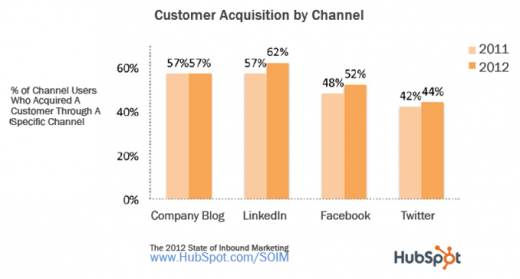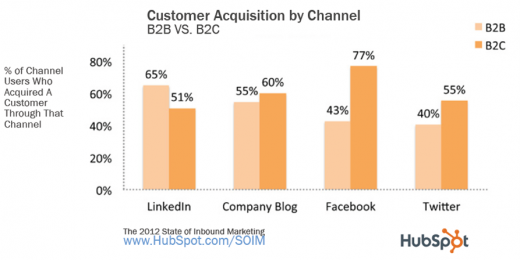
Today HubSpot revealed its 2012 State of Inbound Marketing Report, which identified inbound marketing practices and trends and its impact on lead generation. The study was based on responses from 972 professionals who were familiar with their business’ marketing strategy and included marketers, business owners, entrepreneurs, and executives at companies of various sizes.
It is clear that inbound marketing channels are maintaining their low-cost advantage. The study found that inbound marketing-dominated organizations experience a cost per lead 61% lower than outbound marketing-dominated organizations; furthermore, this finding is very consistent from year to year.
The previous studies showed strikingly similar results: the 2010 survey and 2011 survey showed that inbound marketing-centric organizations experienced a 60% and 62% lower cost per lead respectively. The average cost per lead for outbound-dominated businesses was $346, while inbound businesses reported their leads cost $135 on average. Blogs, social media and organic search maintained the top slots as least expensive channels, with blogs having the highest instance of being reported as “below average cost.”
Due to this success, 89% of businesses are either maintaining or increasing their inbound marketing budgets. Among the 47% of respondents with increased inbound marketing budgets, the most commonly cited reason was “past success with inbound marketing.”
Marketers are allocating more of their lead generation budgets to social media and company blogs. This is true for small businesses especially; they plan to spend dramatically more of their budgets on social media and blogs as these channels tend to generate real customers.
This year will see growth in social media use across the spectrum. 62% of companies said that social media had become more important as a source of leads in the past six months. Blogs are equally important to marketers. They are planning to continue to focus on their blogging strategy and frequency of posts (the survey shows a direct correlation between blog post frequency and new customers acquired). An impressive 25% of respondents rated their company blog as “critical” to their business and 81% of users rated company blogs as “useful” or better.

The survey results clearly identify that inbound leads cost less; but are they better quality? Well, according to the study they appear to be. Leads from inbound links (referrals) are five times more likely to become customers than outbound leads. And SEO leads have a 14.6% close rate, while outbound sourced leads have a 1.7% close rate.
While both B2C and B2B companies were able to acquire customers through the channels below, there was a strong disparity in effectiveness depending on the type of business. The best platform for B2B companies was LinkedIn with 65% of respondents acquiring a customer through that channel, while 77% of B2C companies said that they had acquired a customer through Facebook.

Businesses small and large are transforming their marketing efforts to focus more on inbound programs that allow customers to find them. And those that are pursuing this strategy more aggressively seem to reap larger benefits.
André Klaassen via shutterstock
Get the TNW newsletter
Get the most important tech news in your inbox each week.





